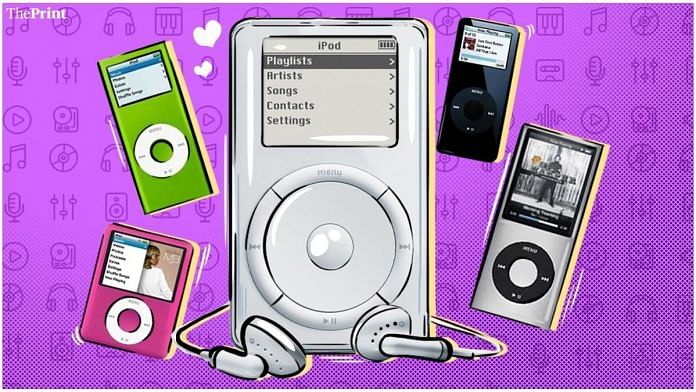New Delhi: As a 10-year-old, all that had mattered to Vikrant Mehra, a marketing manager in Bengaluru, was an Apple iPod that came into his life as a birthday present.
“For the longest time, my love for music lived inside that 80 GB iPod,” Mehra, now 25, told ThePrint.
The portable media player was nothing less than magic for him. It gave him the first ‘formal introduction’ to the world of music — different genres, albums, as well as album art.
“I began to really obsess about music after I got the iPod as a birthday present when I turned 10. It also had a feature that allowed a user to scroll through music, while looking at the album art, making me obsess over the art along with the music,” he added.
While Mehra did not turn out to be a professional musician, he is effortless with the guitar, and is happiest picking strings or strumming along with his friends.
With the advent of the iPod in the early 2000s, millennials went from a CD-burning generation to those cool kids with hands-free music.
“It’s the most culturally important invention of our time,” noted Aman Misra, a PhD candidate with the University of Tennessee. “It changed everything. I felt a knot in my stomach when it was announced that Apple is discontinuing it,” Aman lamented.
After over a two-decade run, Apple Tuesday announced that it was discontinuing the last model of the iconic music player.
Also read: From frosty reception to now making upma, how Kellogg’s found a place on Indian breakfast table
The iconic iPod
iPod was launched by Apple in 2001. It wasn’t the first MP3 player in the market — the equally iconic Sony Walkman was still very much in vogue.
However, as an article in The Quint noted, a bigger storage allowing users to pack in up to 1,000 songs on a small device, as well as a longer battery life, made the iPod an instant hit.
Apple revolutioned the music industry with its hands-free iPods. By 2003, the tech giant introduced iPods with 120 GB storage, allowing one to store up to 10,000 songs at one go.
“We used to compete with friends in school, about song videos we had on our gadgets. And play videos we discovered after school hours,” Misra added.
Now that smartphones have made devices like iPods obsolete, it would perhaps be difficult for a young reader to imagine the craze and emotional value that these MP3 players held for an entire generation of music lovers. At the peak of its popularity, iPods raked in 40 per cent of Apple’s revenue.
Some of the other more recent revolution in music consumption can be attributed to streaming sites like Spotify, Apple Music, and others that allow listening to music online.
Various kinds of iPods
In the two decades of its run, the iPod came in various shapes and sizes. In the beginning, it was a tiny screen with four navigation buttons. This look was continued for gen 2 and 3 iPods as well.
A makeover for iPods came in 2004, with a touch sensitive play wheel and unique colour panels. By 2005, iPods were coming with screens as big as smartphones and a video playing feature, offering up to 80 GB storage.
Other than the classic line, iPod Minis were also introduced that stayed in the market from 2004-05. These were replaced by the iPod Nano, introduced in September 2006, which didn’t have a screen. Steve Jobs called it “a full-featured iPod in an impossibly small size”. By the time the Nano was discontinued in 2017, it was a fully touch screen device and offered an FM radio feature too.
Meanwhile, there was the iPod Shuffle that could hold up to 240 songs. There was also the iPod Touch that looked similar to the iPhone. The iPod Touch was launched in 2007, as was the iPhone.
By 2009, the iPhone replaced iPods to become the king of all Apple devices. With iPhones having an inbuilt Apple Music that can store songs, the iPod slowly became redundant and faded away from people’s lives.
The iPod Touch was last updated in 2019 and now, in 2022, we bid our final farewell to this flagship product that made our lives better as we plugged in a pair of headphones.
Also read: Hari Sadu – Naukri.com’s bad boss from 2006 ad still present during ‘The Great Resignation’






